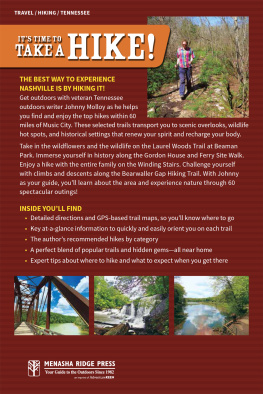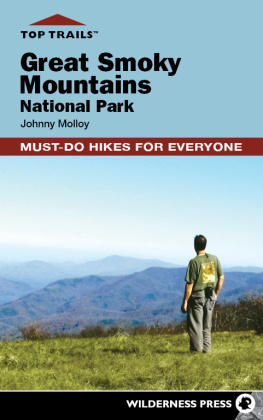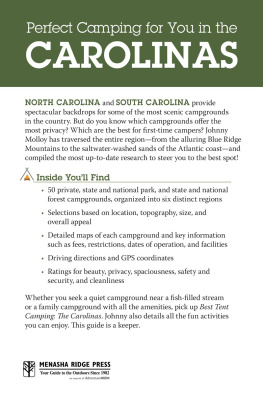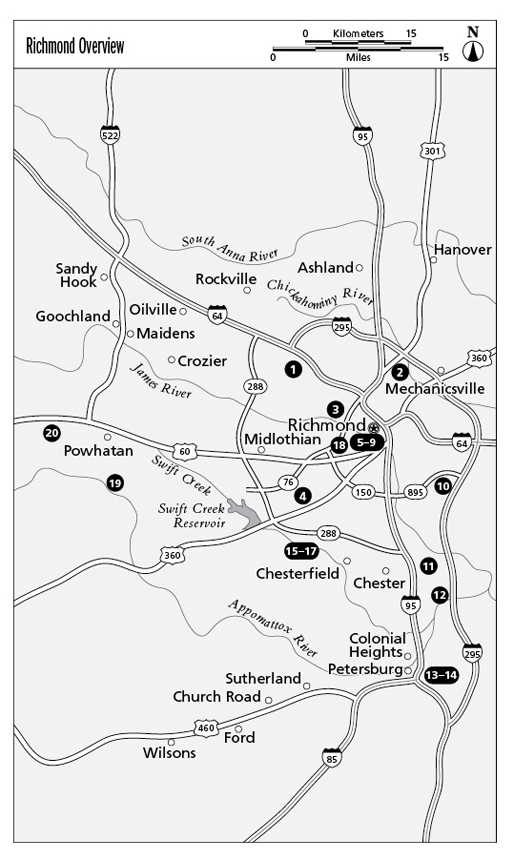Best Easy Day Hikes Series
Best Easy Day Hikes Richmond, Virginia
Johnny Molloy
Copyright 2010 by Morris Book Publishing, LLC
ALL RIGHTS RESERVED. No part of this book may be reproduced or transmitted in any form by any means, electronic or mechanical, including photocopying and recording, or by any information storage and retrieval system, except as may be expressly permitted in writing from the publisher. Requests for permission should be addressed to Globe Pequot Press, Attn: Rights and Permissions Department, P.O. Box 480, Guilford, CT 06437.
FalconGuides is an imprint of Globe Pequot Press, and Falcon, FalconGuides, and Outfit Your Mind are registered trademarks of Morris Book Publishing, LLC.
Maps by Off Route Inc. Morris Book Publishing, LLC
Library of Congress Cataloging-in-Publication Data
Molloy, Johnny, 1961
Best easy day hikes, Richmond, Virginia / Johnny Molloy.
p. cm. -- (Falconguides)
ISBN 978-1-4930-0544-4
1. Hiking--Virginia--Richmond Region--Guidebooks. 2. Trails--Virginia--Richmond Region--Guidebooks. 3. Richmond Region (Va.)--Guidebooks. I. Title.
GV199.42.V8M65 2010
796.5109755'451--dc22
2009043061
The author and Globe Pequot Press assume no liability for accidents happening to, or injuries sustained by, readers who engage in the activities described in this book.
Contents
The Hikes
Acknowledgments
Thanks to all the people who helped me with this book, especially Pamela Morgan. Thanks to Nathan Burrell, coordinator of Richmonds trails, to Jim Hunt and Lightfoot, too. Also, thanks to all the park personnel who answered my tireless questions while trying to manage these jewels of the Old Dominion. The biggest thanks go to the hikers of Richmond and the greater capital area, for without yall the trails wouldnt be there in the first place.
Introduction
The gray boulder on Belle Isle sat perilously close to raucous rapids of the James River. I stood atop the rock looking northward across the water, toward downtown. The outspread landscape contained parts of James River Park, the location of many hikes in this book. My mind soared beyond downtown while mentally recounting all the scenic hikes of greater Richmond. Nearby, Gregorys Pond lay silent beside the wooded trails of Rockwood Park. To the east the fountain of Dorey Lake greeted hikers. To the north the green oasis of Deep Run Park shaded walking paths used by daily exercisers, while Three Lakes Park contained a watery trailside getaway. To the south stood the large jewel of Pocahontas State Park, where natural beauty overlain with the historic Civilian Conservation Corps past made the trail system a delight, demanding multiple hikes for inclusion in this book. Dutch Gap Conservation Area was laced with miles of alluring trails and a chance to visit a re-created English village from the 1600s. Dodd Park offered bluffside hiking along the Appomattox River and a fascinating boardwalk over Ashton Creek Marsh. The hikes at Petersburg National Battlefield explored Civil War history amid rolling hills divided by quiet streams. Other destinations were developed purely with recreation in mind. Hikers and mountain bikers enjoyed a network of hillside paths. I scanned west to Powhatan and Amelia wildlife management areas, where Richmond residents can enjoy rural walks in large preserved areas, maybe to spot a deer or wild turkey.
With this book in handand willing feetyou can explore the greater Richmond region. No matter where you go, the trails in this book will enhance your outdoor experience and leave you appreciating the natural splendors of the greater capital area. Enjoy.
The Nature of Richmond and the Greater Capital Region
Richmonds hiking grounds range from single-track wooded trails along bountiful lakes and streams to flat and paved downtown strolls. Hikes in this guide cover the gamut. While by definition a best easy day hike is not strenuous and generally poses little danger to the traveler, knowing a few details about the nature of greater Richmond will enhance your explorations.
Weather
Richmond certainly experiences all four seasons. Summer can be warm, with occasional downright hot spells, and is the least popular hiking season. Thunderstorms can pop up in the afternoons. I recommend hiking during the early morning or late in the evening in summer. Hiking increases when the first northerly fronts of fall sweep cool, clear air across central Virginia. Crisp mornings give way to warm afternoons. Fall is drier than summer and is the driest of all seasons. Winter will bring frigid subfreezing days and chilling rains, even snow. However, a brisk hiking pace will keep you warm. Each cold month has several days of mild weather. Spring will be more variable. A warm day can be followed by a cold one. Extensive spring rains bring regrowth but also keep hikers indoors. But any avid hiker will find more good hiking days than they will have time to hike in spring and every other season.
Critters
Richmond trail treaders will encounter mostly benign creatures on these trails, such as deer, squirrels, rabbits, wild turkeys, and a variety of songbirds. More rarely seen (during the daylight hours especially) are coyotes, raccoons, and opossums. Deer in some of the parks are remarkably tame and may linger on or close to the trail as you approach. If you feel uncomfortable when encountering any critter, keep your distance and they will generally keep theirs.
Be Prepared
Hiking in greater Richmond is generally safe. Still, hikers should be prepared, whether they are out for a short stroll at James River Park or venturing into the secluded Powhatan Wildlife Management Area. Some specific advice:
- Know the basics of first aid, including how to treat bleeding, bites and stings, and fractures, strains, or sprains. Pack a first-aid kit on each excursion.
- Familiarize yourself with the symptoms of heat exhaustion and heat stroke. Heat exhaustion symptoms include heavy sweating, muscle cramps, headache, dizziness, and fainting. Should you or any of your hiking party exhibit any of these symptoms, cool the victim down immediately by rehydrating and getting him or her to an air-conditioned location. Cold showers also help reduce body temperature. Heat stroke is much more serious: The victim may lose consciousness and the skin is hot and dry to the touch. In this event, call 911 immediately.
- Regardless of the weather, your body needs a lot of water while hiking. A full 32-ounce bottle is the minimum for these short hikes, but more is always better. Bring a full water bottle, whether water is available along the trail or not.
- Dont drink from streams, rivers, creeks, or lakes without treating or filtering the water first. Waterways and water bodies may host a variety of contaminants, including giardia, which can cause serious intestinal unrest.
- Prepare for extremes of both heat and cold by dressing in layers.
- Carry a backpack in which you can store extra clothing, ample drinking water and food, and whatever goodies, like guidebooks, cameras, and binoculars, you might want. Consider bringing a GPS equipped with tracking capabilities.












